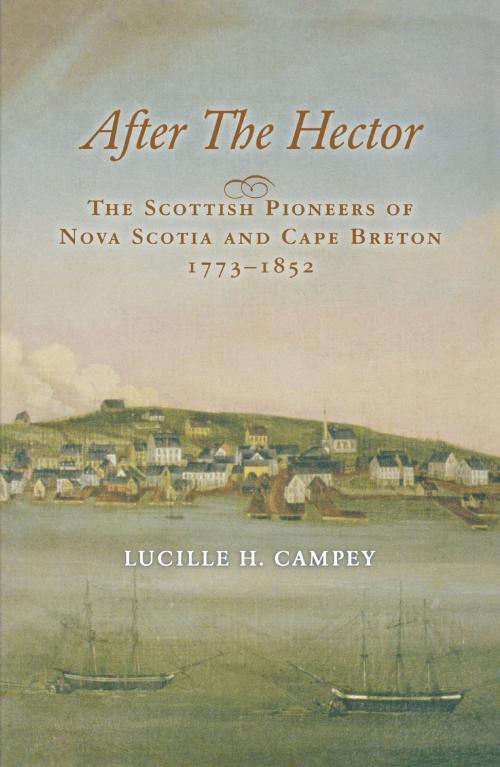After the Hector
The Scottish Pioneers of Nova Scotia and Cape Breton, 1773-1852
Nonfiction, History, Canada, Social & Cultural Studies, Social Science, Cultural Studies, Emigration & Immigration| Author: | Lucille H. Campey | ISBN: | 9781554880683 |
| Publisher: | Dundurn | Publication: | May 15, 2007 |
| Imprint: | Natural Heritage | Language: | English |
| Author: | Lucille H. Campey |
| ISBN: | 9781554880683 |
| Publisher: | Dundurn |
| Publication: | May 15, 2007 |
| Imprint: | Natural Heritage |
| Language: | English |
This is the first fully documented and detailed account, produced in recent times, of one of the greatest early migrations of Scots to North America. The arrival of the Hector in 1773, with nearly 200 Scottish passengers, sparked a huge influx of Scots to Nova Scotia and Cape Breton. Thousands of Scots, mainly from the Highlands and Islands, streamed into the province during the late 1700s and the first half of the nineteenth century.
Lucille Campey traces the process of emigration and explains why Scots chose their different settlement locations in Nova Scotia and Cape Breton. Much detailed information has been distilled to provide new insights on how, why and when the province came to acquire its distinctive Scottish communities. Challenging the widely held assumption that this was primarily a flight from poverty, After the Hector reveals how Scots were being influenced by positive factors, such as the opportunity for greater freedoms and better livelihoods.
The suffering and turmoil of the later Highland Clearances have cast a long shadow over earlier events, creating a false impression that all emigration had been forced on people. Hard facts show that most emigration was voluntary, self-financed and pursued by people expecting to improve their economic prospects. A combination of push and pull factors brought Scots to Nova Scotia, laying down a rich and deep seam of Scottish culture that continues to flourish. Extensively documented with all known passenger lists and details of over three hundred ship crossings, this book tells their story.
"The saga of the Scots who found a home away from home in Nova Scotia, told in a straightforward, unembellished, no-nonsense style with some surprises along the way. This book contains much of vital interest to historians and genealogists."
- Professor Edward J. Cowan, University of Glasgow
"...a well-written, crisp narrative that provides a useful outline of the known Scottish settlements up to the middle of the 19th century...avoid[s] the sentimental 'victim & scapegoat approach' to the topic and instead has provided an account of the attractions and mechanisms of settlement...."
- Professor Michael Vance, St. Mary's University, Halifax
This is the first fully documented and detailed account, produced in recent times, of one of the greatest early migrations of Scots to North America. The arrival of the Hector in 1773, with nearly 200 Scottish passengers, sparked a huge influx of Scots to Nova Scotia and Cape Breton. Thousands of Scots, mainly from the Highlands and Islands, streamed into the province during the late 1700s and the first half of the nineteenth century.
Lucille Campey traces the process of emigration and explains why Scots chose their different settlement locations in Nova Scotia and Cape Breton. Much detailed information has been distilled to provide new insights on how, why and when the province came to acquire its distinctive Scottish communities. Challenging the widely held assumption that this was primarily a flight from poverty, After the Hector reveals how Scots were being influenced by positive factors, such as the opportunity for greater freedoms and better livelihoods.
The suffering and turmoil of the later Highland Clearances have cast a long shadow over earlier events, creating a false impression that all emigration had been forced on people. Hard facts show that most emigration was voluntary, self-financed and pursued by people expecting to improve their economic prospects. A combination of push and pull factors brought Scots to Nova Scotia, laying down a rich and deep seam of Scottish culture that continues to flourish. Extensively documented with all known passenger lists and details of over three hundred ship crossings, this book tells their story.
"The saga of the Scots who found a home away from home in Nova Scotia, told in a straightforward, unembellished, no-nonsense style with some surprises along the way. This book contains much of vital interest to historians and genealogists."
- Professor Edward J. Cowan, University of Glasgow
"...a well-written, crisp narrative that provides a useful outline of the known Scottish settlements up to the middle of the 19th century...avoid[s] the sentimental 'victim & scapegoat approach' to the topic and instead has provided an account of the attractions and mechanisms of settlement...."
- Professor Michael Vance, St. Mary's University, Halifax















